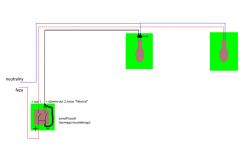I warmly welcome.
I would like to replace my light switch with "intelligent", ie one that can be switched both manually and via Wifi.
More precisely, I chose Sonoff Touch due to the ease of reprogramming it (adapting it to my own home management application).
I have two light sources on the ceiling, I also mean a switch with 2 buttons:
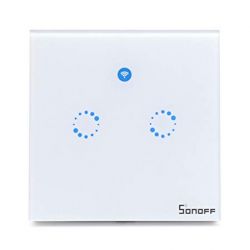
The problem, however, is that only the phase is fed to the old switch, which it divides into two circuits to both light sources. Sonoff Touch, on the other hand, still needs a neutral wire, as it also includes a microcontroller and a WiFi module.
This is the current situation with the old switch:
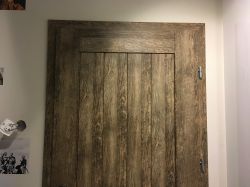
From what I assume, the neutral cable goes along with the phase cable over the door frame on the right (on the other side of the wall, on the right, above the door frames I have a box and all fuses), then the phase goes down to the switch alone, hence 2 cables for 2 light sources return . And then, together with the neutral, they go to the ceiling and along it (suspended ceiling). I think it confirms this photo from renovation (after replacing the electrical system by an electrician .
As you can see, the apartment has already been renovated, the walls are freshly painted, there are also frames made of a material similar to a photo wallpaper, very close to the door. That is why I am looking for a solution that finally will not spoil the appearance of the wall and it does not require complete repainting (very problematic due to, among others, the above-mentioned frames from the photo wallpaper) or dusting (problem with securing all elements and frames).
For every forging, smoothing, laying cables in the wall I am going to hire a suitable specialist - unfortunately, I do not know a trusted man at the moment for plastering / masking cables.
The solutions I have considered:
1. Forge (not me personally, of course) from the switch to the neutral cable, connect the Sonoff Touch with the neutral, hide the furrow.
Advantages: The installation then works exactly as it was supposed to.
Disadvantages: problem with masking the resulting furrow - can it be done so that it does not stand out from the wall at all? I know the problem will be with the shade of the paint when it's been old for some time, but now I'm thinking more about the edge than the color.
2. As above, but lead the neutral from the wardrobe to the right next to it (this is the white surface on the right - there I can forge myself and cover everything with a board), from here to the door frame and from the door frame to the light source:
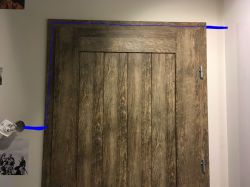
Advantages: Smaller wall forging area.
Cons: Still needs to be masked. Cable in the frame.
3. As in 1. , but run the cables up the wall through the grilles.
I do not include: I don't like it aesthetically.
4. Leaving the old switch, mounting in the light sources (of course I already have a phase and neutral output there) one Sonoff (no longer Touch, but an ordinary Wifi-controlled switch).
Pros: No hammering, no thought of how to leave a wall nice.
Cons: Installation doesn't quite work as I want. More precisely, there is 1 case: when I turn off the light manually, I can't turn it on via Wifi (and vice versa). It works, however, when I would like to e.g. turn off the light in the room while watching a movie. Worse with turning on.
5. Smart switches that do not require a neutral cable.
Pros: No hammering, no thought of how to leave a wall nice.
Disadvantages: none?
Honestly speaking, I do not understand how such a switch is able to function without a neutral when it cuts off the electricity to the light.
However, I found switches that supposedly work, e.g. SESOO SY3-02 to radio waves. Integrating it into my home management system would be to build an appropriate emitter.
What do you think? Maybe you have better ideas or comments on any of the solutions?
I really don't want to disfigure the wall. However, the difference in the cost of solutions is not that important anymore.
Added after 27 [minutes]:
I also found this version of the solution with the use of Sonoff Touch and Sonoff at each light source, with a change in the wiring at the light source, unfortunately I do not fully understand the mechanism of action by which I would use the phase as neutral in Sonoff Touch and how to convert it into 2 light sources:
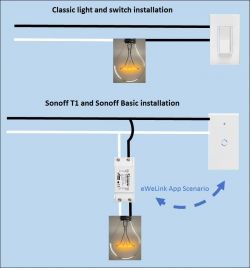
I would like to replace my light switch with "intelligent", ie one that can be switched both manually and via Wifi.
More precisely, I chose Sonoff Touch due to the ease of reprogramming it (adapting it to my own home management application).
I have two light sources on the ceiling, I also mean a switch with 2 buttons:

The problem, however, is that only the phase is fed to the old switch, which it divides into two circuits to both light sources. Sonoff Touch, on the other hand, still needs a neutral wire, as it also includes a microcontroller and a WiFi module.
This is the current situation with the old switch:

From what I assume, the neutral cable goes along with the phase cable over the door frame on the right (on the other side of the wall, on the right, above the door frames I have a box and all fuses), then the phase goes down to the switch alone, hence 2 cables for 2 light sources return . And then, together with the neutral, they go to the ceiling and along it (suspended ceiling). I think it confirms this photo from renovation (after replacing the electrical system by an electrician .
As you can see, the apartment has already been renovated, the walls are freshly painted, there are also frames made of a material similar to a photo wallpaper, very close to the door. That is why I am looking for a solution that finally will not spoil the appearance of the wall and it does not require complete repainting (very problematic due to, among others, the above-mentioned frames from the photo wallpaper) or dusting (problem with securing all elements and frames).
For every forging, smoothing, laying cables in the wall I am going to hire a suitable specialist - unfortunately, I do not know a trusted man at the moment for plastering / masking cables.
The solutions I have considered:
1. Forge (not me personally, of course) from the switch to the neutral cable, connect the Sonoff Touch with the neutral, hide the furrow.
Advantages: The installation then works exactly as it was supposed to.
Disadvantages: problem with masking the resulting furrow - can it be done so that it does not stand out from the wall at all? I know the problem will be with the shade of the paint when it's been old for some time, but now I'm thinking more about the edge than the color.
2. As above, but lead the neutral from the wardrobe to the right next to it (this is the white surface on the right - there I can forge myself and cover everything with a board), from here to the door frame and from the door frame to the light source:

Advantages: Smaller wall forging area.
Cons: Still needs to be masked. Cable in the frame.
3. As in 1. , but run the cables up the wall through the grilles.
I do not include: I don't like it aesthetically.
4. Leaving the old switch, mounting in the light sources (of course I already have a phase and neutral output there) one Sonoff (no longer Touch, but an ordinary Wifi-controlled switch).
Pros: No hammering, no thought of how to leave a wall nice.
Cons: Installation doesn't quite work as I want. More precisely, there is 1 case: when I turn off the light manually, I can't turn it on via Wifi (and vice versa). It works, however, when I would like to e.g. turn off the light in the room while watching a movie. Worse with turning on.
5. Smart switches that do not require a neutral cable.
Pros: No hammering, no thought of how to leave a wall nice.
Disadvantages: none?
Honestly speaking, I do not understand how such a switch is able to function without a neutral when it cuts off the electricity to the light.
However, I found switches that supposedly work, e.g. SESOO SY3-02 to radio waves. Integrating it into my home management system would be to build an appropriate emitter.
What do you think? Maybe you have better ideas or comments on any of the solutions?
I really don't want to disfigure the wall. However, the difference in the cost of solutions is not that important anymore.
Added after 27 [minutes]:
I also found this version of the solution with the use of Sonoff Touch and Sonoff at each light source, with a change in the wiring at the light source, unfortunately I do not fully understand the mechanism of action by which I would use the phase as neutral in Sonoff Touch and how to convert it into 2 light sources:





